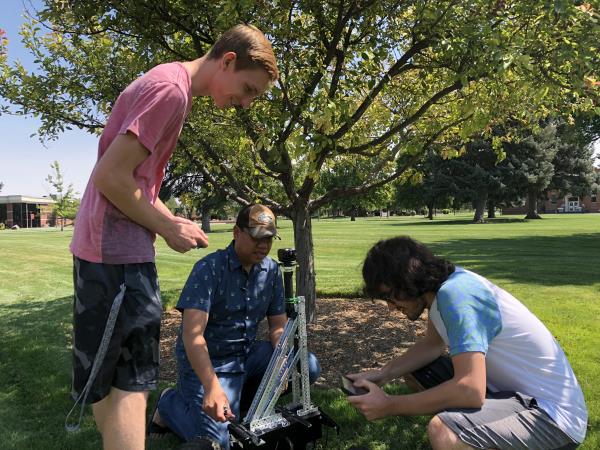Using artificial intelligence to estimate fruit yields

By Sean Ellis
Idaho Farm Bureau Federation
NAMPA – Northwest Nazarene University researchers are working on a project that seeks to use artificial intelligence to more quickly and accurately make early season fruit yield estimates.
NNU Professor Duke Bulanon last year received a $65,000 specialty crop grant from the Idaho State Department of Agriculture for the project, which will develop a deep learning algorithm to more accurately estimate fruit yields early in the season.
The current practice for making early season fruit yield estimates is to manually count fruits on a select number of trees and then use the average number of fruit to calculate yields.
This method is time consuming, labor intensive and includes only a limited sample size, limiting its reliability, Bulanon said. Using artificial intelligence to perform that task will improve the fruit yield estimate by enabling faster counting over a wider range of trees in an orchard, he said.
Having a reliable early season fruit yield estimate will allow growers to better plan their harvesting operations and resources in advance, and better prepare post-harvesting logistics when it comes to ordering boxes and fruit covers, setting up storage equipment and reserving packing houses.
Growers will also be able to better pre-market their fruit, which could result in them obtaining more competitive prices as much as 15 percent better, Bulanon said.
“Predicting the fruit yield, especially early in the season, is very important for farmers because if they market their fruit late in the season, the price of the fruit goes down,” he said. “If they have a reliable fruit yield estimate early in the season, they will have a more competitive price.”
According to Bulanon’s grant proposal, “This project … will position Idaho in the forefront of precision agriculture technologies for specialty crops.”
To develop this type of artificial intelligence tool, Bulanon and his team of robotic vision researchers at NNU will teach a deep learning algorithm to correctly identify fruit on the tree between the blossom period and fruit maturity.
That will include taking thousands of images of blossoms and unripe fruit and feeding them into a computer.
“It’s like teaching a baby, this is a ball,” Bulanon said. “It will learn how to recognize what an apple is. Artificial intelligence mimics the way a human learns.”
“We have to tell the machine, ‘This is an apple,’” said Connor Nogales, an undergraduate research assistant who is working on the project. “When it learns that, it can do that autonomously and a lot faster than a human.”
He said it’s more accurate to call the process “machine learning,” because it “doesn’t actually have its own intelligence. We’re just teaching it what to do.”
Tyler Hestand, an undergraduate research assistant, said the algorithm will predict fruit yields much faster than any human ever could.
“You just take a picture and seconds later it spits out an estimate of how much fruit you’re going to have,” he said. “The speed is definitely a major advantage with artificial intelligence.”
Bulanon and his team will work on the project with local fruit growers.
Chad Henggeler, field manager for Henggeler Packing Co., one of Idaho’s largest fruit companies, said having reliable yield estimates very early in the season could prove particularly beneficial to the Fruitland company when it comes to marketing its fruit.
“If it works, it would help growers have the information we need so we know how much to market,” he said.
When it comes to setting up things like storage, boxes and labor, “All of those things would definitely make a difference,” he added.
Michael Williamson, manager of Williamson Orchards and Vineyards in Caldwell, said most of the company’s fruit is pre-sold.
“We get the best return if we line up those sales in May or June,” he said. “If we can predict our yields very early in the season in a precise kind of manner, that would be very helpful.”
This isn’t the first time Bulanon has led projects designed to benefit Idaho farmers. He and his team of researchers are also working on a robotic platform called “IdaBot” that could be a low-cost way of helping farmers control input costs through the use of robotic automation.
The goal of that project is to create a simple robot that can navigate an orchard or vineyard autonomously and be used to apply chemicals.
Bulanon has also spearheaded a project to develop an unmanned aerial vehicle that takes multispectral images that farmers can quickly analyze on their computers to determine if their plants are suffering from diseases, water stress or nutrient deficiency.
He said projects like those and the current one are long-term efforts that could help Idaho producers in the future.
“We may not be impacting the growers in Idaho right now, right away, but we may be in 10 or 15 years from now,” Bulanon said.
Still can't find what you are looking for? Find by topic:
- County Presidents & Board Information
- County Resource Page
- Delegate Form
- Discount Programs
- Discussion Meet
- Discussion Meet - High School
- Education Programs
- Events
- Excellence Award (YF&R)
- Expense Voucher
- Flickr
- Gem State Producer
- High School Discussion Meet
- High School Speech Contest
- Hope in Idaho Ag
- House of Delegates Credentials Form
- IFBF Board of Directors
- IFBF Staff
- Insurance
- Issue Advisory
- Legislative Action Program
- Legislative Issues
- Library
- MAC Trailer
- Magazines
- Map My Benefits
- Member Benefits
- Member Discount
- Membership Application
- Mental Health Resources
- Mission Statement
- Moving Agriculture to the Classroom
- Newsletter Sign up
- News Releases
- News Room
- Open Range Law
- Photo Contest
Thank You to Our Partners









